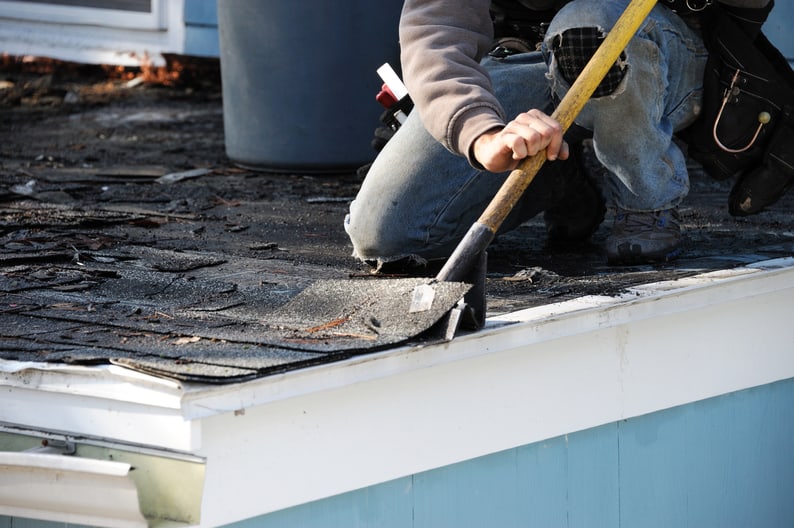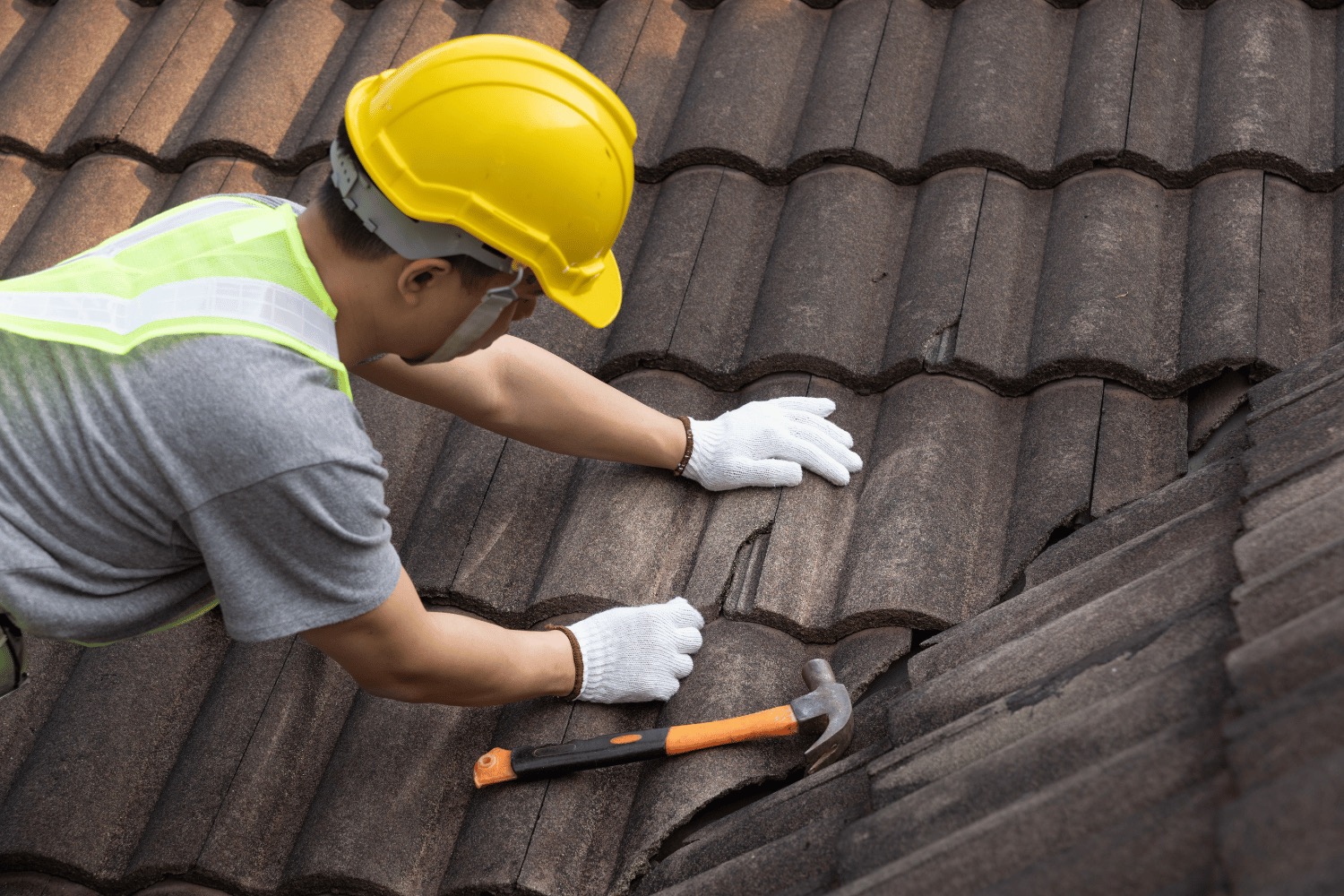Seasonal Roof Covering Fixing Checklist: Prepare Your Roof Covering for every single Weather
By complying with a seasonal roof repair work list, you can stay in advance of prospective issues. Let's check out exactly how appropriate maintenance can guard your home and expand your roofing's life-span.
Examining Your Roofing System for Winter Months Readiness
As winter months approaches, it's necessary to evaluate your roofing to confirm it can endure extreme climate condition. Begin by inspecting for missing out on or harmed tiles; also a small concern can bring about substantial leakages when snow and ice collect. Next, check out the flashing around vents and smokeshafts-- this location is often at risk to water invasion.
Do not neglect to try to find indications of drooping or irregular surface areas, as these could indicate structural issues. Furthermore, verify your rain gutters are clear; blocked seamless gutters can cause ice dams that harm your roofing.
 roof repair
roof repair
Spring Cleaning: Clearing Debris and Checking for Damage
Once wintertime's grasp launches, it's time to take on spring cleaning on your roof covering by eliminating debris and checking for any type of damage. Start by evaluating your roofing for fallen branches, leaves, and various other particles that can trap moisture and create rot. A tidy roofing system advertises much better drainage and stops mold development.
Following, grab a strong ladder and very carefully examine shingles for fractures or missing pieces. Take note of locations around smokeshafts and vents, as these spots are susceptible to leakages. Do not fail to remember to examine your seamless gutters, guaranteeing they're cost-free from blockages that could lead to water merging.
While you're up there, try to find signs of wear, like corrosion on metal blinking or loose seals around skylights. If you detect any type of concerns, addressing them now can save you from costly repair work later on. A little springtime cleaning goes a long way in keeping your roof's integrity.
Summertime Warmth: Examining Your Roof Covering for Heat-Related Issues
As summer heat increases, it's necessary to inspect your roof for heat-related problems. Look for any type of shingle damage, look for indicators of warmth buckling, and examine exactly how well your roofing system aerates. Taking these steps now can protect against bigger troubles in the future.
Check for Tile Damages
 roof repair
roof repair
Inspect for Heat Buckling
Warm fastening is an usual problem that can emerge during the scorching summer season months, and it's important to examine for it on your roof. Beginning by inspecting your roof covering visually; look for any uneven surface areas or lifted sides. If you spot any kind of indications of heat buckling, it's vital to resolve them promptly to avoid further damage.
Review Roofing System Air Flow Efficiency
After inspecting for heat fastening, it's vital to review your roof covering's air flow efficiency. Proper air flow aids control temperature level and dampness, preventing damage from extreme warmth. Keep in mind, keeping good ventilation not only prolongs your roofing system's life but additionally enhances your home's total energy efficiency, guaranteeing convenience during those warm summertime months.
Rainy Period Preparedness: Guaranteeing Proper Water Drainage
As the wet season methods, you require to ensure your roofing system's drain system is all set to manage hefty downpours. Beginning by checking your downspouts and rain gutters, and ensure they're free from particles. Don't forget to examine the blinking and seals to prevent leaks and water damages.
Evaluate Downspouts and seamless gutters
Start by inspecting for any kind of visible particles, like fallen leaves or branches, that could block the circulation of water. Next off, analyze the downspouts for blockages or damage; a blocked downspout can trigger water to overflow, possibly harmful your roofing and structure. If you spot any kind of concerns, resolve them promptly to stop pricey repair work.
Clean Roofing System Surface Debris
To guarantee your roofing can manage the rainy season, it's important to clean up any type of debris from the surface on a regular basis. Leaves, branches, and dirt can collect, blocking water drainage paths and creating water to swimming pool. This trapped water can bring about leaks and damage with time. Grab a sturdy ladder and examine your roof for any kind of build-up. Use a roofing rake or broom to delicately eliminate debris, taking care not to harm the tiles. Don't forget to inspect your rain gutters also, guaranteeing they're clear and operating correctly. After cleaning, monitor your roofing system after heavy rains to find any kind of prospective concerns early. Maintaining your roof clear of debris is vital for protecting against costly repair services down the line.
Check Flashing and Seals
After clearing your roof covering of particles, take a better look at the flashing and seals around skylights, smokeshafts, and vents. If you notice any damages, it's crucial to repair or replace it immediately. Guaranteeing these components are in excellent condition will certainly assist keep correct water drainage and protect your home from water damages during heavy rainfall.
Monitoring and Preserving Roofing Seals and Flashing
While it may seem easy to ignore, keeping and checking roofing system seals and flashing is crucial for protecting against leaks and water damages. If you spot any kind of problems, it's finest to reseal them with proper roofing sealer to assure a limited fit.
Following, analyze the blinking, which routes water away from critical locations. Examine for rust, loosened areas, or bent edges.
Lastly, do not forget to cleanse off any kind of particles that could block the seals or flashing. Keeping these parts in great shape will help safeguard your roofing versus the elements and extend its life expectancy.
Seamless Gutter Upkeep: Keeping Water Streaming Efficiently
Because your gutters play a crucial duty in guiding rain away from your home, routine upkeep is essential for preventing water damage and structure problems. A clogged rain gutter can lead to water overflow, which might damage your roof and exterior siding.
Next, evaluate for any signs of rust, holes, or drooping areas. If you discover any kind of damage, fixing or replace the afflicted components immediately. Confirm downspouts are directing water at least six feet far from your foundation. If essential., think about adding expansions.
Ultimately, examine that your gutters are effectively sloped, preferably a quarter inch for every ten feet. This slope guarantees water moves efficiently toward the downspouts. Routine maintenance will maintain your gutters operating efficiently and secure your home from expensive repair work.
Arranging Professional Examinations for Comprehensive Treatment
Routinely organizing professional assessments is necessary for preserving your roofing's integrity. This timing enables you to deal with any type of damage caused by winter months weather condition or summer storms.
Throughout examinations, specialists will certainly analyze tiles, flashing, and ventilation, making certain whatever's in top shape. They'll also look for indications of wear, leaks, or mold, which you could overlook. Scheduling these evaluations not just expands your roofing's life-span however likewise offers you comfort.
If you're unclear about the condition of your roofing, do not hesitate to call an expert. Buying these exams now can save you a lot later on. Prioritize your roofing's wellness, and you'll be well-prepared for whatever weather comes your way.
Regularly Asked Inquiries
How Commonly Should I Inspect My Roofing System Throughout the Year?
You should inspect your roofing system at the very least two times a year, preferably in spring and loss. After serious weather condition events, check for damages too. Routine examinations assist you catch problems early and save money on repair services.
What Indications Show I Need a Roofing Replacement Rather of Repair Work?
 roof repair
roof repair
Can I Carry Out Roof Covering Services Myself, or Should I Hire a Professional?
You can do small roofing system repair work on your own if you fit with elevations and basic devices, yet hiring a professional assurances safety and correct work. Don't run the risk of damage; it may be worth the investment for assurance.
What Are the Best Materials for Roof Repairs in Various Climates?
For different environments, you'll desire materials like asphalt shingles for moderate locations, metal roofing for extremes, and clay floor tiles for warm areas. Always take into consideration neighborhood climate patterns to assure your roofing system holds up against the aspects efficiently.
Just How Do Roof Covering Warranties Influence Seasonal Upkeep Responsibilities?
Roofing service warranties typically define maintenance responsibilities, so you'll require to evaluate the terms. If you do not preserve your roofing as required, you may nullify the warranty, leaving you in charge of expensive repairs.
Seasonal Roofing Repair Service List: Prepare Your Roof Covering for Every Weather Condition
As soon as wintertime's grasp launches, it's time to deal with spring cleansing on your roofing system by clearing away particles and examining for any damage. Check for any kind of shingle damage, look for indicators of heat fastening, and examine how well your roofing ventilates. If you detect any kind of issues, consider contacting an expert for repair work to keep your roofing in top shape and secure your home from potential water damage.
While it could appear simple to forget, checking and maintaining roof covering seals and blinking is important for preventing leakages and water damage.